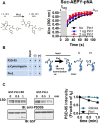An Alternative Pin1 Binding and Isomerization Site in the N-Terminus Domain of PSD-95
- PMID: 32256312
- PMCID: PMC7094161
- DOI: 10.3389/fnmol.2020.00031
An Alternative Pin1 Binding and Isomerization Site in the N-Terminus Domain of PSD-95
Abstract
Phosphorylation-dependent peptidyl-prolyl cis-trans isomerization plays key roles in cell cycle progression, the pathogenesis of cancer, and age-related neurodegeneration. Most of our knowledge about the role of phosphorylation-dependent peptidyl-prolyl cis-trans isomerization and the enzyme catalyzing this reaction, the peptidyl-prolyl isomerase (Pin1), is largely limited to proteins not present in neurons. Only a handful of examples have shown that phosphorylation-dependent peptidyl-prolyl cis-trans isomerization, Pin1 binding, or Pin1-mediated peptidyl-prolyl cis-trans isomerization regulate proteins present at excitatory synapses. In this work, I confirm previous findings showing that Pin1 binds postsynaptic density protein-95 (PSD-95) and identify an alternative binding site in the phosphorylated N-terminus of the PSD-95. Pin1 associates via its WW domain with phosphorylated threonine (T19) and serine (S25) in the N-terminus domain of PSD-95 and this association alters the local conformation of PSD-95. Most importantly, I show that proline-directed phosphorylation of the N-terminus domain of PSD-95 alters the local conformation of this region. Therefore, proline-directed phosphorylation of the N-terminus of PSD-95, Pin1 association, and peptidyl-prolyl cis-trans isomerization may all play a role in excitatory synaptic function and synapse development.
Keywords: Pin1; cis-trans isomerization; excitatory synaptic transmission; postsynaptic density protein 95; proline-directed phosphorylation.
Copyright © 2020 Delgado.
Figures




Similar articles
-
Pin1 Binding to Phosphorylated PSD-95 Regulates the Number of Functional Excitatory Synapses.Front Mol Neurosci. 2020 Mar 13;13:10. doi: 10.3389/fnmol.2020.00010. eCollection 2020. Front Mol Neurosci. 2020. PMID: 32231520 Free PMC article.
-
Pin1 Modulates the Synaptic Content of NMDA Receptors via Prolyl-Isomerization of PSD-95.J Neurosci. 2016 May 18;36(20):5437-47. doi: 10.1523/JNEUROSCI.3124-15.2016. J Neurosci. 2016. PMID: 27194325 Free PMC article.
-
Role of phosphorylation in determining the backbone dynamics of the serine/threonine-proline motif and Pin1 substrate recognition.Biochemistry. 1998 Apr 21;37(16):5566-75. doi: 10.1021/bi973060z. Biochemistry. 1998. PMID: 9548941
-
Phosphorylation-Dependent Pin1 Isomerization of ATR: Its Role in Regulating ATR's Anti-apoptotic Function at Mitochondria, and the Implications in Cancer.Front Cell Dev Biol. 2020 Apr 30;8:281. doi: 10.3389/fcell.2020.00281. eCollection 2020. Front Cell Dev Biol. 2020. PMID: 32426354 Free PMC article. Review.
-
The Multiple Roles of Peptidyl Prolyl Isomerases in Brain Cancer.Biomolecules. 2018 Oct 11;8(4):112. doi: 10.3390/biom8040112. Biomolecules. 2018. PMID: 30314361 Free PMC article. Review.
Cited by
-
The role of peptidyl-prolyl isomerase Pin1 in neuronal signaling in epilepsy.Front Mol Neurosci. 2022 Oct 11;15:1006419. doi: 10.3389/fnmol.2022.1006419. eCollection 2022. Front Mol Neurosci. 2022. PMID: 36304997 Free PMC article. Review.
-
Pin1-Catalyzed Conformation Changes Regulate Protein Ubiquitination and Degradation.Cells. 2024 Apr 23;13(9):731. doi: 10.3390/cells13090731. Cells. 2024. PMID: 38727267 Free PMC article. Review.
References
LinkOut - more resources
Full Text Sources
Other Literature Sources
Research Materials
Miscellaneous

